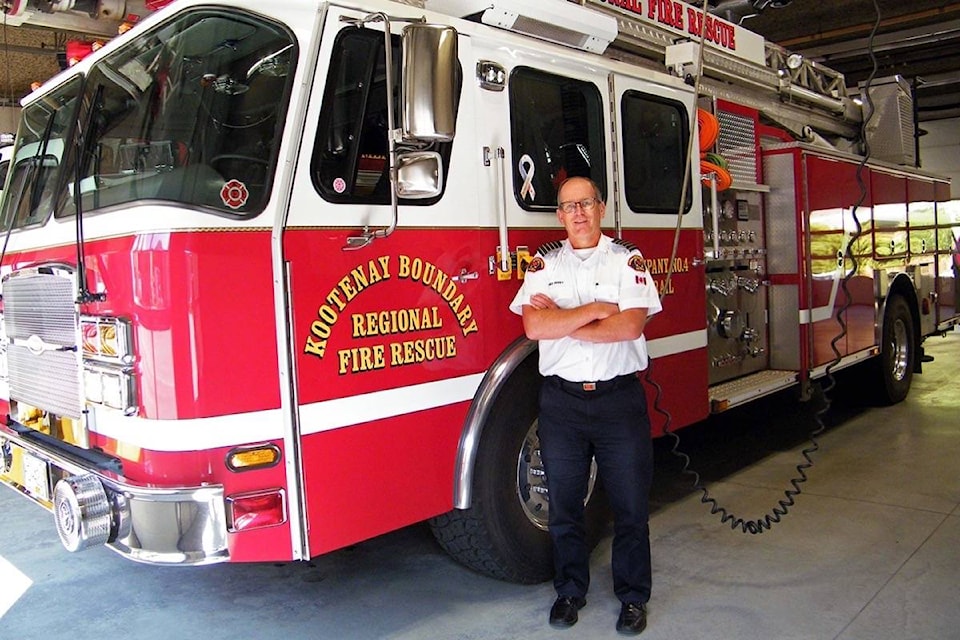All six fire stations protecting properties from Rossland to Trail and Genelle to the Beaver Valley, will be maintained status quo as will the service levels provided by the regional fire department.
Previous: Vehicle fires and 2018 hazmat calls surge in Greater Trail
Previous: RDKB emergency calls climb in 2017
Operations at Kootenay Boundary Regional Fire Rescue (KBRFR) have been under the magnifying glass for several months. The full review recently wound down, concluding that levels of service and structure of the department meet the ongoing needs of the region and will meet the future standards in legislation, training and service.
“The review was a comprehensive look at how we run our fire rescue service and why we run it the way we do,” says Fire Chief Dan Derby.
“This was a great opportunity to share information with our re-elected and newly-elected officials about the challenges of operating our fire rescue services in the most efficient way possible while still meeting current legal, training and response requirements.”
Three key outcomes of the service review are that the regional district will: maintain the existing level of full service training, fire suppression, rescue, first responder medical and prevention services; maintain the existing six fire stations; and communicate the review’s end results with the public.
“This has been a very rigorous process and we’ve had some really good discussions at our East End Services Committee table,” said Ali Grieve, committee chair and Area A director.
“What made this review successful is that we all shared the goal of making absolutely certain we can continue to meet the needs of residents who rely on our emergency responders to be there when they need them most,” she explained.
“We had to know unequivocally that the service has right levels of staffing, equipment and expertise at each of our six stations and I am very pleased to say that we are where we should be.”
Kootenay Boundary Regional Fire Rescue full-time (career) and paid-on-call fire fighters are trained to fight structural fires, wildland-urban interface fires and to provide first responder medical services.
Specialty rescue training includes high angle rope rescue, swift water rescue, confined space rescue and auto extrication. Out in the community, fire fighters educate kids and adults about fire prevention, inspect all public buildings for fire and life safety, investigate fires and volunteer for many community events to benefit charities and other worthy causes.
“The final step in this review process is to share results with residents of electoral areas A and B/Lower Columbia-Old Glory, Fruitvale, Montrose, Warfield, Rossland and Trail,” said Grieve.
“I hope community members will take a look at what we’ve done, and let us know what they think of this review or anything else related to regional fire and rescue services.”
Kootenay Boundary Regional Fire Rescue Service was created in 1982.
Aside from Station 374 Trail, which is housed in the regional district office on Rossland Avenue, the department has fire halls in Rossland, Warfield, Genelle, Montrose, and Fruitvale.
The service provides overlapping coverage for the large fire protection area that encompasses around 20,000 residents.
In 2018, KBRFR responded to approximately 1,548 calls for service, which averages to one call every five hours.
The fire department’s annual budget, currently standing at $3.7 million, is paid for by taxpayers living in the service area.
In summary, the 2019 property tax requisition had Trail paying 42 per cent or approximately $1.6m; Rossland $676,000 or 18 per cent; Area A $639,000 or 17 per cent; Area B contributed nine per cent or $352,000; Fruitvale’s apportionment was six per cent or $208,000; Warfield $163,000 or four per cent; and Montrose three per cent, or $107,000.
Further, residential property owners are paying about $220 for the service this year. This number is based on a home assessed at $250,000.
newsroom@trailtimes.ca
Like us on Facebook and follow us on Twitter
